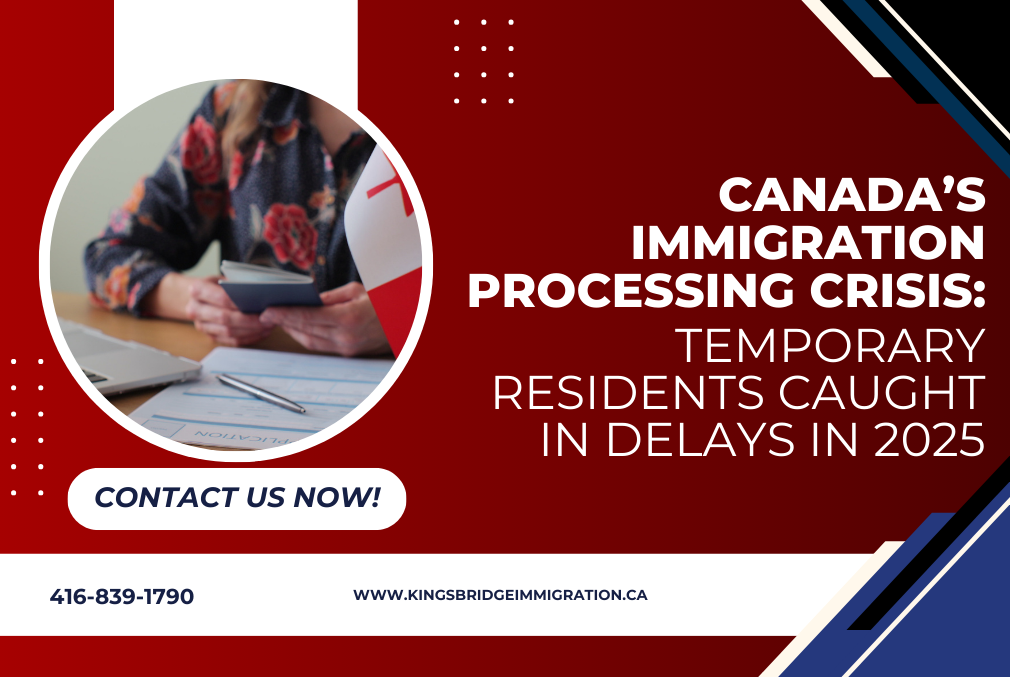
Canada’s immigration system, once seen as a benchmark of efficiency and fairness, is now facing severe delays that are impacting thousands of temporary residents. From stalled visa extensions to years-long waits for permanent residency and spousal sponsorships, the system is under tremendous strain.
Adding to the bottleneck, Employment and Social Development Canada (ESDC) is facing its own backlog in processing Labour Market Impact Assessments (LMIAs)—an essential step for employers seeking to hire foreign workers. Meanwhile, Immigration, Refugees, and Citizenship Canada (IRCC) announced in January 2025 that it would cut 3,300 jobs, further stretching already limited resources.
Observers suggest the government may be intentionally slowing processing times to prompt temporary residents to leave on their own, raising questions about the country’s immigration priorities.
This article delves into the growing human and economic toll of these delays, the structural problems behind them, and what they mean for Canada’s future.
A System Under Pressure: The Immigration Backlog
As of March 31, 2025, IRCC had 1.97 million applications in its inventory—only slightly down from February’s 2.03 million. The number includes citizenship, permanent residency, and temporary residency applications, many of which exceed the government’s standard processing timelines.
Processing times for temporary resident extensions are particularly long:
Visitor visa extensions: 169 days
Study permit extensions: 234 days
Work permit extensions: 237 days
(As of May 13, 2025)
Meanwhile, LMIA processing through ESDC is also experiencing significant delays:
High-wage and low-wage streams: 61 business days
Permanent Residence Stream: Up to 214 business days (over 7 months)
Spousal sponsorships have also slowed dramatically. As of May 2025, average processing times are:
Outside Quebec: 29 months (up from 24 months)
In Quebec: 36 months
Temporary Residents: Living in Limbo
Temporary residents—including students, workers, and visitors—face immense uncertainty. International students, who contribute over $22 billion to Canada’s economy, face risks to their legal status and education due to 234-day wait times for permit extensions. Workers in essential sectors like healthcare and agriculture are waiting an average of 237 days for work permit renewals, threatening their livelihoods.
Visitor visa holders must wait roughly 169 days to extend their stay—with no guarantee of approval after months of waiting.
Critics say the government is using these prolonged timelines to discourage temporary residents from staying, possibly to reduce population pressures.
LMIA Bottlenecks: Employers and Workers Stuck
The LMIA process is essential for employers looking to hire foreign talent through the Temporary Foreign Worker Program. While the Global Talent Stream remains fast (8 business days), most other streams are lagging far behind. The Permanent Residence LMIA stream, crucial for helping workers transition to PR, takes over seven months.
High volumes, seasonal demand, and complex assessments contribute to these delays. Employers must provide extensive documentation, and incomplete applications can extend timelines even further.
The impact is far-reaching: employers struggle to fill jobs, and workers risk losing opportunities while waiting. Once an LMIA is approved, workers still face a 237-day processing time for a work permit.
A Quiet Shift: Government Encouraging Departures?
Canada’s 2025–2027 Immigration Levels Plan targets 395,000 new permanent residents in 2025, focusing largely on economic immigration. However, policy signals suggest a shift away from temporary residents. With a cap on study permits and a pause in Express Entry draws from March to May 2025, pathways to PR for temporary residents are narrowing.
Experts argue these delays may be a strategic move to reduce the number of temporary residents in Canada.
Families Struggle to Reunite
Perhaps the most emotional fallout from these delays is felt by families awaiting spousal sponsorships. Processing now takes over two years outside Quebec and three years within the province.
Cases like one from Cape Breton—where a Canadian man is separated from his Iranian wife—highlight the deep personal toll. Families are facing heartbreak, legal costs, and uncertainty as the backlog for spousal sponsorships continues to grow.
The Numbers and Definitions
As of Q1 2025, there were 3,020,936 non-permanent residents in Canada. This marks the first recorded quarterly drop, but the total remains higher than Q1 2024’s figure of 2,729,771.
A temporary resident is anyone who is not a Canadian citizen or permanent resident but is authorized to live in Canada temporarily—such as international students, foreign workers, and visitors.
A Nation at a Crossroads
Canada’s immigration backlog is not just a policy issue—it’s a humanitarian and economic crisis. With massive processing delays, reduced staffing, and a possible quiet effort to reduce temporary residents, the government is testing its commitment to compassion, family reunification, and workforce stability.
As Canada executes its 2025–2027 Immigration Levels Plan, the challenge will be maintaining the country’s global reputation while supporting the people and families who want to call Canada home.